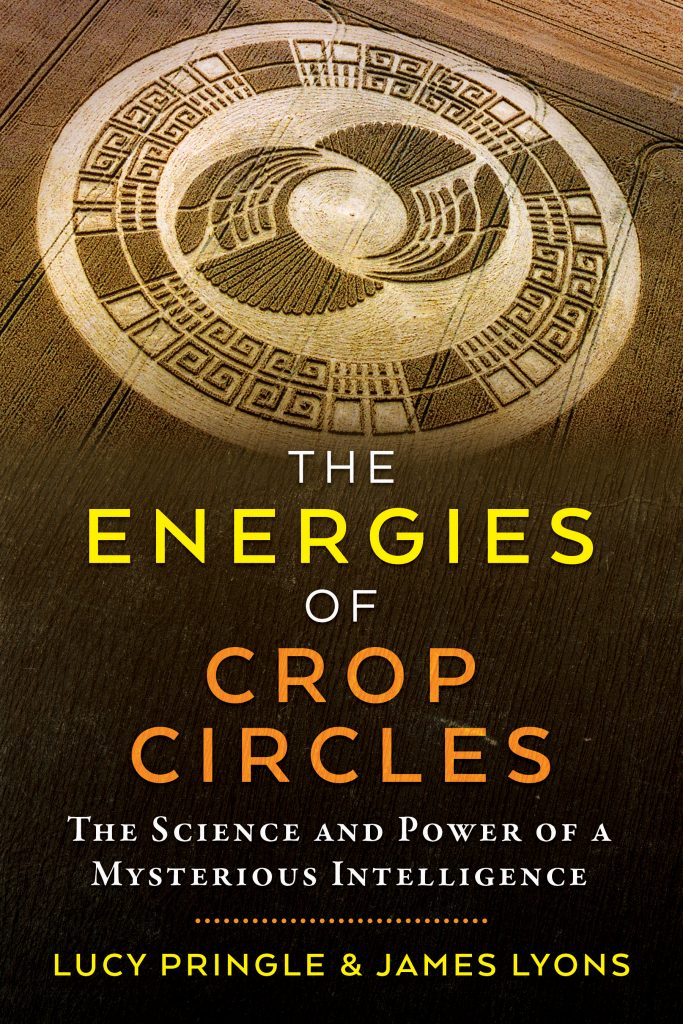The following is excerpted from “Energies of Crop Circles” by Lucy Pringle, published by Inner Traditions.
You have noticed that everything an Indian does is in a circle, and that is because the Power of the World always works in circles, and everything tries to be round. . . . The Sky is round, and I have heard that the Earth is round like a ball, and so are all the stars. The wind, in its greatest power, whirls. Birds make their nest in circles, for theirs is the same religion as ours. . . . Even the seasons form a great circle in their changing, and always come back again to where they were. The life of a man is a circle from childhood to childhood, and so it is in everything where power moves.
Black Elk (Oglala) (1863–1950)
No matter how dismissive skeptics may be about the volume of human and electrical anomalies, animal reactions and behavior are more difficult if not impossible to ignore, and so their behavior is critical to research into crop circles.
We know from the effects on pilots’ instruments that there is a vertical field of “energy” that extends to an unknown height above a crop circle; therefore it comes as no surprise that birds are affected. “Whilst sitting enjoying the food and the view of the stones of Avebury, a wood pigeon flew across the field from an easterly direction. Just outside the formation it seemed to almost hit a wall, making it veer suddenly, around the formation, to the north (it didn’t overfly it at all) and then it continued to fly to the west after its detour.”
Exactly the same effect was recorded in Canada when a skein of geese veered sharply away from flying over a formation, only to regroup directly afterward and continue on their way. Birds have magnetite in their brains and react to magnetic fields.
More sinister were the remains of exploded birds found in the Wanborough crop circle in July 1994. On careful examination it seemed that a bird had exploded in the center of the circle. Christopher Weeks and I found an area measuring in a thirteen- to fourteen-foot radius from the center, covered in blood, tiny feathers, and minute bits of flesh, not just on the surface but penetrating every layer right to ground level. There were no bones or any distinguishable parts of the bird, and the “mess” was totally different in appearance from the pile of feathers in the outer ring, clearly once belonging to a pigeon and clearly killed by a fox. We sent samples to a biologist in Devon who reported that indeed it would appear that a bird had “exploded” and that it was dead at the time of the explosion. I had found empty cartridge cases in the field, and it was clear that the pigeon had been shot and was lying there and had disintegrated when the crop circle force hit the ground.
Another report on the darker side spoke of
the strangest and most chilling thing I have ever seen was the body of a hedgehog which appeared to have been completely drained of body fluids—as if it had been freeze-dried. I grew up in the country, so have seen lots of dead wildlife, but never have I seen anything like this. It was on the path into the formation at Avebury Trusloe, June/July 1991. There appeared to be no external injuries, but it looked almost flat.
The friend who was with me at the time was used to picking up roadkill for a friend of his who is a taxidermist, but he had seen nothing like this. I would have taken it away but my friend was adamant that it was not going in his car!
This report is similar to the dehydrated and flattened porcupines that were found in a crop circle in Canada in 1992. The dehydrated corpses showed no signs of injury or decomposition and did not smell. Animals can sense danger, but both hedgehogs and porcupines rely on their quills to protect them and therefore remain stationary instead of fleeing. In these cases we seem to be dealing with the microwave, infrared area of the electromagnetic spectrum, suggesting that these animals were indeed “microwaved.”
Character Change
Some normally docile creatures seem to behave in uncharacteristic ways when exposed to samples of crops from the formations. Doreen Jenkinson had taken home some wheat from inside a newly formed crop circle, and as soon as she got home her customarily sweet and gentle cat started growling at her in a low tone as Doreen touched the wheat. “I normally hang the wheat up but because of my cat’s reaction I left it in the lavatory. My cat sat ‘guarding’ it for two days. After one day I went to touch the wheat and got the same reaction from her, glaring at me to say ‘No, don’t touch.’ By the second day this reaction disappeared.”
My gray cat, Hero, became obsessed with some stalks of barley from a crop event that I put under the dining room table. He sat there sucking the ears of the barley and growled at me when I tried to remove him. He would sit by the dining room door, dashing in to resume the “sucking” each time I opened the door. I also noticed that his character was changing, and he was becoming aggressive. He was a beautiful big gray cat, and I loved him so much.
Alarm bells started ringing, however, when one time I went into the dining room for something and refused to let him in. I bent down to stroke him as I came out and he suddenly stood up on his hind legs and almost raked my face with his claws. I realized that something was desperately wrong, and despite all treatments, including homeopathic remedies, his day-to-day aggression increased to the point that he became a serious danger to me, and sadly I had to have him put down, which nearly broke my heart.
It all started after he sucked the barley stalks. Had there been some chemical reaction from sucking the stalks? Was it due to various crop sprays used by the farmers?
He Is the Cat’s Whiskers
In early July, I took a party of people from London into the bewitchingly beautiful South Field “Cathedral” formation.
I had given them a talk in the morning, and before I started was surprised to be greeted by a stranger, accompanied by a cat in a British Airways bag slung over her shoulder. The woman asked after my cat, Hero. How did she know about Hero? Of course, I had mentioned him in my book, and Rupert, the Burmese blue, was here to experience the circles for himself.
It was one of those days when every type of weather condition was practicing its skills with the greatest of enthusiasm and gusto. One moment, the Sun would peek its nose through briefly only to be shouldered out by the clouds, the bringers of rain—rain of every sort and description from a drizzle to torrential downpours accompanied by thunder and lightning. It seemed that we had to experience the whole bacchanalian menu of conditions. How were these townies going to survive this wanton display by the elements? They were magnificent: many of them had never been into a crop formation before, and many of them were strangers to the countryside. For them the whole scenario turned into a magical, mystical event as we stood in the formation surrounded by the ancient hills terraced by our ancestors of long ago, the nipple on the breast of Adam’s Grave standing out proudly, reminding us of our connection with Gaia.
What about Rupert? If an animal could talk then surely he would be the first; he was a most sagacious beast and apparently accompanied his owner nearly everywhere. He was attached to a very long leather lead giving him maximum independence. His owner Mary Spain writes:
The most interesting aspect of Rupert’s reactions was that he behaved exactly as he does when visiting a church—he has visited numerous country churches on our travels. He was respectful, quiet, alert, and very interested. When on a country walk he is far more boisterous. Another interesting thing was that, uninvited, he went up to a stranger sitting meditating and sat down beside her. Although he is always perfectly polite to strangers, he is not normally friendly to this extent and has never sat on anyone’s lap but mine.
It may be coincidence, but Rupert’s constipation problems were sorted out after the experience!
An intriguing end to this story came to my notice. Mary Spain wrote telling me that five days after visiting the formation, she went to have her hair cut.
My hairdresser couldn’t understand the amount of static in my hair until I explained that it had been full of energy since I visited a crop circle at the weekend. She grew very excited saying that only that morning she had seen a beautiful picture of a crop circle in the Daily Mail and had read of Rupert’s experiences.
Horse Sense
A beautiful Daisy Chain formation in barley was discovered at Cheriton, near Cheesefoot Head, Hampshire, on July 6, 1997. The surrounding twenty-nine circles around the flattened center each contained a central tuft of standing crop; diagonally across the center of the formation were two “Magimix blades” consisting of minute and perfect circles.
An American researcher was the first to discover and visit the formation. She had neglected to ask the farmer’s permission and, as she was standing in the circle, the farmer’s wife came riding down the tramlines toward her. As the woman got nearer she rode toward the unfortunate researcher in an aggressive manner, but the moment her horse reached the edge of the circle it stopped, and despite several cracks of the whip, refused to budge, becoming quite agitated. This clearly added to the rider’s annoyance, and she shouted, “I do not believe in these %#@& circles!”
“Maybe you don’t, but your horse certainly does!” replied the researcher.
In that year, one of my first visits was to the “Bear’s Paw” near Morested, Hampshire, which appeared in early May in barley. A rider was trotting her gray horse along the path dividing the field in two. I managed to catch her before she disappeared out of sight and asked her if she would mind riding her horse into the formation.
She was happy to do so, saying she was fascinated by the crop circles and had taken her horse into several. She felt he was a good judge of the circle’s authenticity. Her horse displayed no visible sign of agitation, moving around the formation and standing still when reined in. The rider however remarked that his breathing rate had noticeably increased.
What made a Rottweiler rushing ahead of its owner into a crop circle suddenly stop dead, roll over, and fall asleep just before it reached a terrified woman sitting meditating in the center?
Equally strange was the behavior of two normally friendly Labradors, as shown when they attacked each other and then a woman inside a formation.
What conclusion can we reach, if any? Can we ascribe this varied and bizarre behavior to certain frequencies in the electromagnetic field, or could we be dealing with the effects of crop spraying?
I suspect that the young wheat in that field had already had a potent mix of a whole range of herbicides, insecticides, and fungicides sprayed upon it, with a lot more to go.
I really feel that people should look on the website of various organizations to find out more about these symptoms. I know there is a couple working at the University of Iowa on agricultural chemical poisoning. We should remember that most spray applications are what are called “tank mixes” where, to save time and money, farmers mix several sprays at once, often up to four different brands. This can cause a little-understood range of chemical interactions.
I am now beginning to believe that many of the experiences people record within these fields are directly related to chemical poisoning, and anyone going into a field would be well advised to check with the farmer what his spraying regime had been. I know that, speaking personally, I will not be entering another circle unless I have first checked with the farmer about when the field was last sprayed.
Comments by James Lyons
So far, our consideration of ambient energy within crop circles has, not surprisingly, focused on humans. However, as we have already observed, we must at least consider the circles’ interaction with other living species.
Here we’ll focus on two creatures: dogs, who on many occasions have accompanied their owners into crop circles, and birds, which, of course, are more likely to overfly formations and yet are still susceptible to the specific ambient energy fields.
Since these creatures possess similar consciousness-related cell structures as humans, we need to assess what similarities and differences relate to behavior. As with all living creatures, it is the structure of the brain that mainly accounts for the observed effects. With regard to humans, we need to consider brain frequency and energy-detection processes. Concentrating on the latter, which has so far received little attention, there is one common feature, including among humans, which can be clearly identified as the key element of energy detection.
We assume that the eyes are the major information-detection system, but sight clearly depends on light waves within a relatively narrow frequency spectrum, namely, the colors of the rainbow. Yet a completely separate system is needed to detect and process information when we consider the ambient waves within a crop circle. These waves are the spiraling waves of electric charge, which dominate the structure of the Cosmos.
We mentioned above that these are called torsion waves, as per our Slinky model; these waves can be detected by what in early Yogic philosophy was called the Third Eye, which is connected to the pineal gland, so called because of its pinecone-shaped structure. The gland is in essence made of quartz and hence is, as all Healers know, electrically active.
It operates in a completely different way from the eyes, which use frequencies far higher than the fundamental resonance frequency of quartz. The frequency of quartz is 28 kHz, a little above the hearing limit of humans. This frequency has recently been identified in the columnar vortex rising from the Bosnian Pyramid of the Sun. It is also the frequency used in low-voltage health zappers that interact at the cellular level. The third eye is the detector of all the spiraling waves we find in not only crop circles but all ancient sites.
Dogs have a higher frequency-response range than humans and are aware of the Earth vibrations. Depending on the spectrum of these frequencies, a dog will behave in differing ways. As young people devour the frequencies of rock music, older folk mostly prefer Vivaldi!
It is the bird scenario that is perhaps even more fascinating. For around 150 years, people have thought that birds navigate by detecting the Earth’s magnetic field, especially magnetic north. To date, despite enormous effort, no one has found any sign of such a feature that could possibly be used for navigation.
However, a completely new model is emerging based on the use of the pineal gland as the key detector of the key frequency of the Earth, which is identifiable at many locations on our planet. Like the Bosnian pyramid and crop circles, as well as ancient sites and medieval churches, there is a columnar vortex of energy generated at points on the Earth’s energy grid that provides an enormous directional signal like a lighthouse.
There have been many situations in which flocks of birds flying toward ancient sites or crop circles split into two groups, each flying around the column and joining up again once past it. They have no problem detecting the spiraling energy via their pineal systems. Work continues on how pineal glands link via the hypothalamus to the brain to reveal and analyze the emitted columnar vortex—the perfect navigation system.
Additionally, a pineal gland can act like an accelerometer as well as a rate gyro, the two key building blocks of an inertial navigation system. Perhaps the most revealing aspect of this new hypothesis is that the subtle energy field around the pineal gland reduces sharply to zero when its axis is pointing at magnetic north.
Thus we see that crop circle energies, created initially by rising toroidal waveforms that rise from underground water, when breaking through the Earth’s surface, form a vacuum space to draw down the crop. This leaves a spiraling columnar vortex in which we find a whole spectrum of frequencies, mostly within the frequency band compatible with the detection systems of humans, animals, and birds. It is therefore of no surprise that reactions to these signals are perfectly normal. The frequencies involved can generate both good and bad responses, dependent on the health condition of the human or animal.
To conclude this section, it is worth noting that it is at long last possible to purchase Radionic Healing units. These are quite old in concept, but computerized equipment now enables such units, via handheld probes, to analyze the frequency response of a complete patient.
As an orchestral conductor tunes up his players prior to a concert, modern radionics units analyze each organ of the body, for example, the heart or lungs, to see how out of tune a patient is. With such a “map” it becomes possible to retune that organ to its correct operating frequency. No pharmaceuticals are needed. Such units are now being evaluated in the NHS, and large-scale implementation of the technology is envisaged.
***














